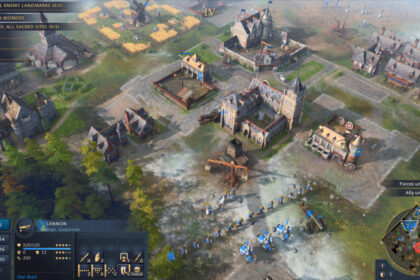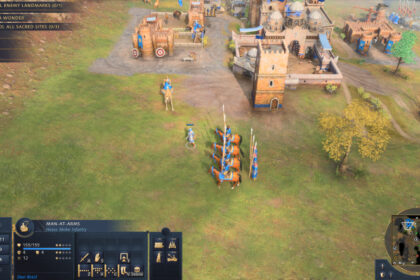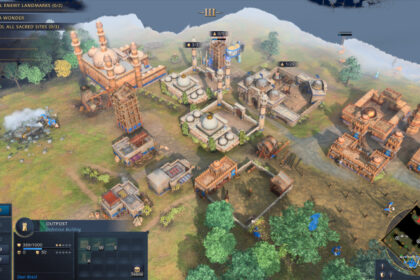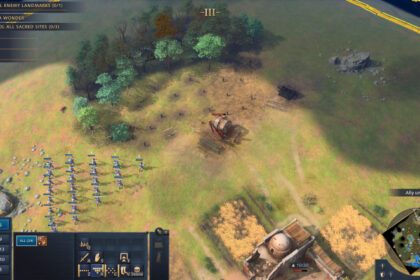The Holy Roman Empire is a standard civilization in many ways. Although it does have its unique units and structures, it’s not like you’re learning how to play as the Mongols in Age of Empires 4.
They are a 2 Stars difficulty civilization that has the following traits: Infantry, Religion, Defense.
The Holy Roman Empire counts with a powerful infantry, fast ways to recover from attacks, strong counter-attacks on the field, and early military units.
In Age of Empires IV, the Holy Roman Empire differs from the others due to their early religious units and how those units interact with their Villagers and armies.
Due to the constant, close relationship of the Roman Economy and religious units, players of the Holy Roman Empire will frequently have a way to make their units last longer when they survive a battle.
If this is a Civilization that sounds interesting to you, stick around. In this guide, you are going to learn everything you need to know about how to play as the Holy Roman Empire in Age of Empires 4.
Characteristics of the Holy Roman Empire
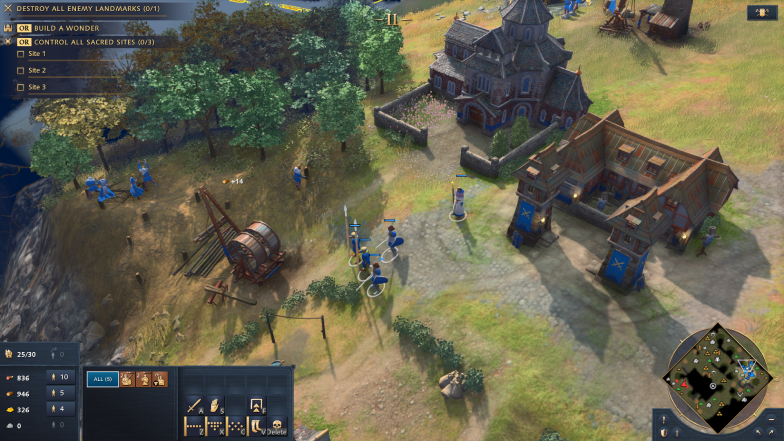
This is a civilization that has early access to two units and has some unique military units that can cause a lot of trouble to the enemy if constantly healed.
Not only that, but they also have buildings with influence. If you know how to play as the Rus, this is a lot like the area surrounding their Wood Fortresses that provide bonuses to nearby structures.
Due to, generally speaking, being a more standard civilization, there are many possible tactics that you can implement when playing as this civilization.
However, one must first learn the basics of the civilization to then what is possible to do with it. So here are the unique characteristics of the Holy Roman Empire and what they do.
Army of the Empire
You have access to very powerful technology that makes your infantry significantly more potent, which, combined with the presence of Prelates, allows you to be much more effective than other civilizations would be during the early game.
Not only that, your Man-at-Arms are available one Age earlier than they are to other civilizations. This might facilitate rushes and also protect you from powerful rush builds such as the French Knight Rush or the English Longbowmen Rush.
Religious Zeal
You get extra gold from Relics, and you can inspire units — such as Villagers, making their resource gathering more effective — with the use of your unique religious unit, the Prelate.
Prelates can be produced since the game starts from the Town Center, which is a great advantage to the Holy Roman Empire since they are basically the monks of this civilization. You don’t even have to build an expensive building in order to have some.
Influence
This civilization’s Town Center has an Area of Influence around it. Buildings constructed within the influence of a Town Center — or Town Keep — gain an ability called “Emergency Repairs,” which can be used to repair the building.
This incentivizes you to surround your Town Keeps and Town Center with the most important structures for your civilization since they can be protected by the Town Centers and repaired during or after combat has happened.
Unique Units
The Holy Roman Empire does not have an impressive number of unique units. However, they are both powerful units that can dictate the course of a match when well used.
They are also great together. You can have a long-lasting, dangerous army by putting together a frontline of swordsmen with a decent area of effect damage that is constantly healed by your Prelates during wars.
- Prelate: Provides Holy Inspiration to Villagers, making them work 40% faster for 30 seconds.
- Landsknecht: Light Infantry with a large two-handed sword, capable of doing significant area damage.
Civilization Bonuses
Now that we’ve gone through the most noticeable characteristics of the Holy Roman Empire, here’s the summary with all the bonuses you get from playing this civilization:
- Prelate available in the Dark Age — the first Age
- Early Man-at-Arms available in the Feudal Age — the second Age
- You can garrison Relics inside of Outposts, Keeps, and Towers to improve their sight range, weapon range, armor, and damage.
- Docks can garrison Relics, increasing the attack speed of all ships by 5% per Relic (to a maximum of 25%)
- Cost of emplacements on Outposts, Wall Towers, and Keeps is reduced by 25%
Landmarks
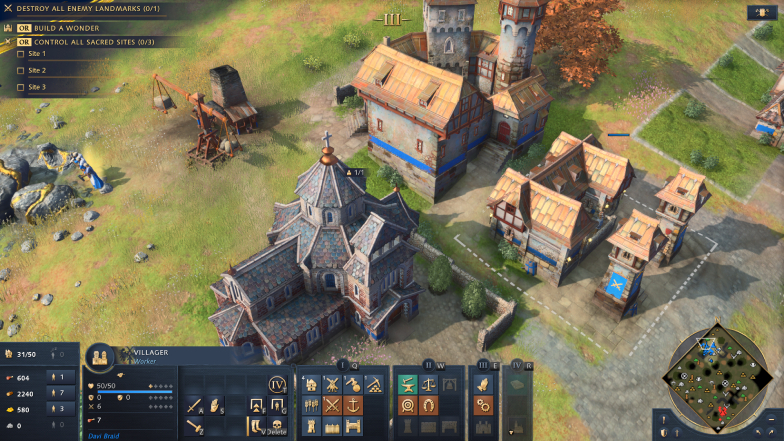
The Holy Roman Empire has some truly interesting Landmarks, such as the Aachen Chapel, that can generate a huge area of Influence around it, and the Burgrave Palace that produces 5 units of infantry at a time.
Here are all the Landmarks of this civilization divided by era:
Feudal Age
- Meinwerk Palace: — This Landmark acts like a Blacksmith. Technology researched here costs -25% less.
- Aachen Chapel: — This Landmark has an area of influence that inspires units in a large radius around it as long as you have a Prelate garrisoned.
Castle Age
- Burgrave Palace: The Palace can produce 5 infantry units at a time, being remarkably powerful for those who are constantly harassing the adversary.
- Regnitz Cathedral: Relics placed in the Regnitz Cathedral generate 200% gold for every minute they’re in there. You can place up to 3 relics in the Regnitz Cathedral.
Imperial Age
- Palace of Swabia: Acts as a Town Center, but it only takes 1/4 of the usual time to produce Villagers. They also cost only 1/4 of the usual cost as well. The Palace of Swabia is 20% cheaper than what it should be for an Imperial Age Landmark.
- Elzbach Palace: This Landmark Acts just like a Keep, but it has a bonus of +50% health. It also causes all buildings within influence to take 1/3 less damage than that would usually take when attacked
Holy Empire Tactics
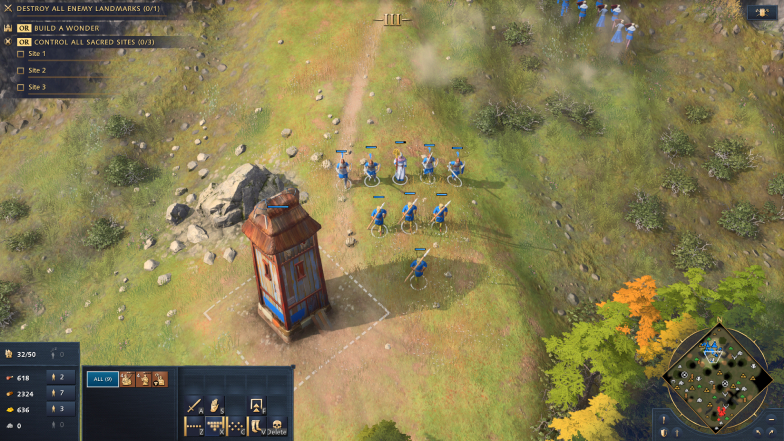
Alright, so the Holy Roman Empire has a unit that inspires Villagers and heals their soldiers. This sounds great, but what now?
Due to being a very well-rounded civilization, you don’t have a single, clear path for this civilization. Meaning, you are most likely free to choose your path and go for it. It also means that although it can do pretty much anything well — like playing offensively or defensively — it most likely won’t do it as well as civilizations that are focused on it.
Take advantage of your early military units to protect yourself and scout the map while you decide what to do next. Prelates can keep your Scout and other units alive even when they have been harassed.
Please note that up to the mid game, the Holy Roman Empire might have a noticeable advantage when fighting in its own territory — due to the Prelates you will most likely have on the field by then.
Early religious units also let this civilization capture relics and Sacred Sites quite early in the game. If you don’t know how important this is, you should take a look on how to win a game of Age of Empires 4.
So spy on your enemy, make use of the fact this civilization does almost everything decently, and when you have an opportunity to use your strengths — like the Prelate and the Landsknechts — make sure you do use it.

